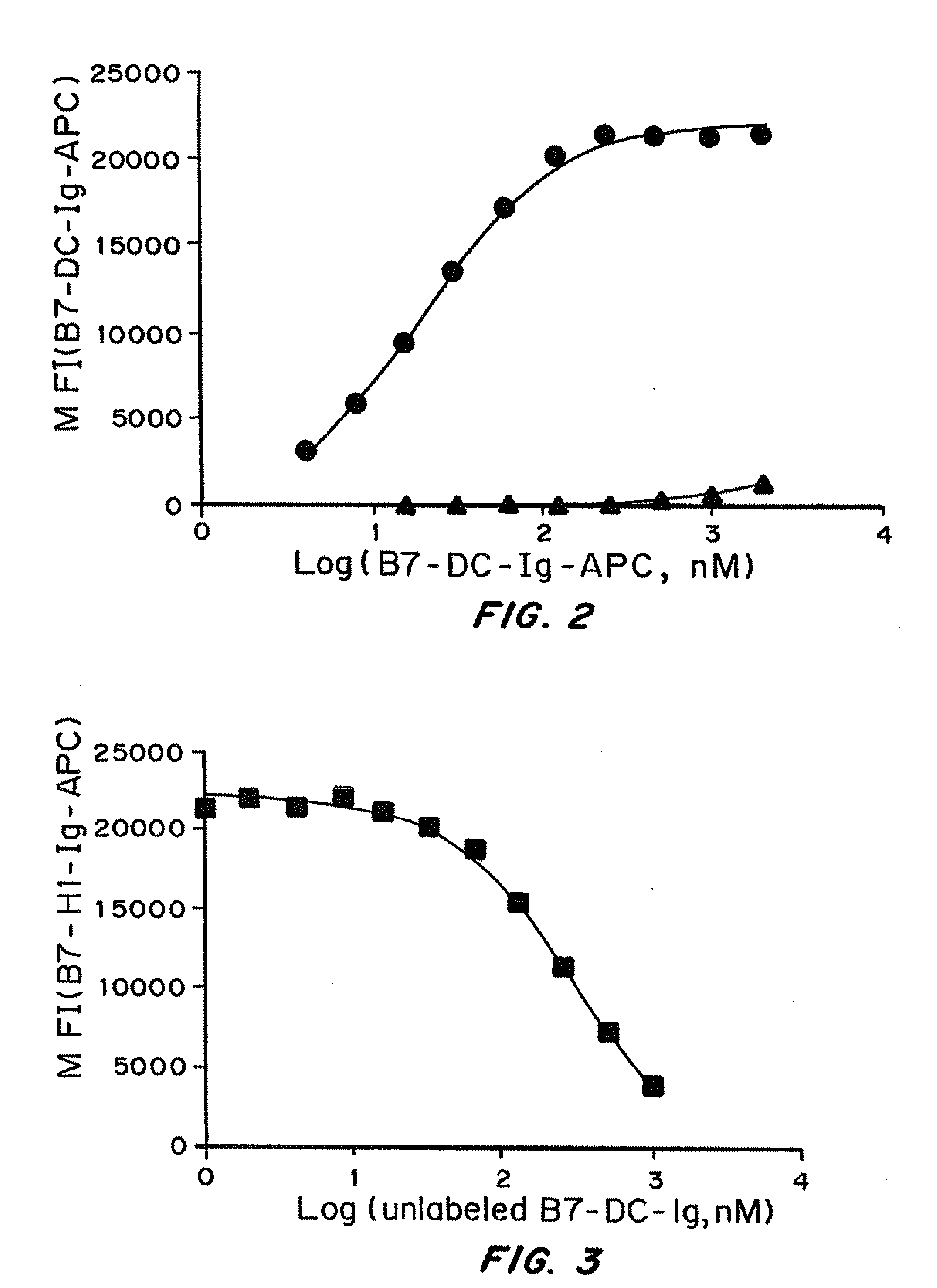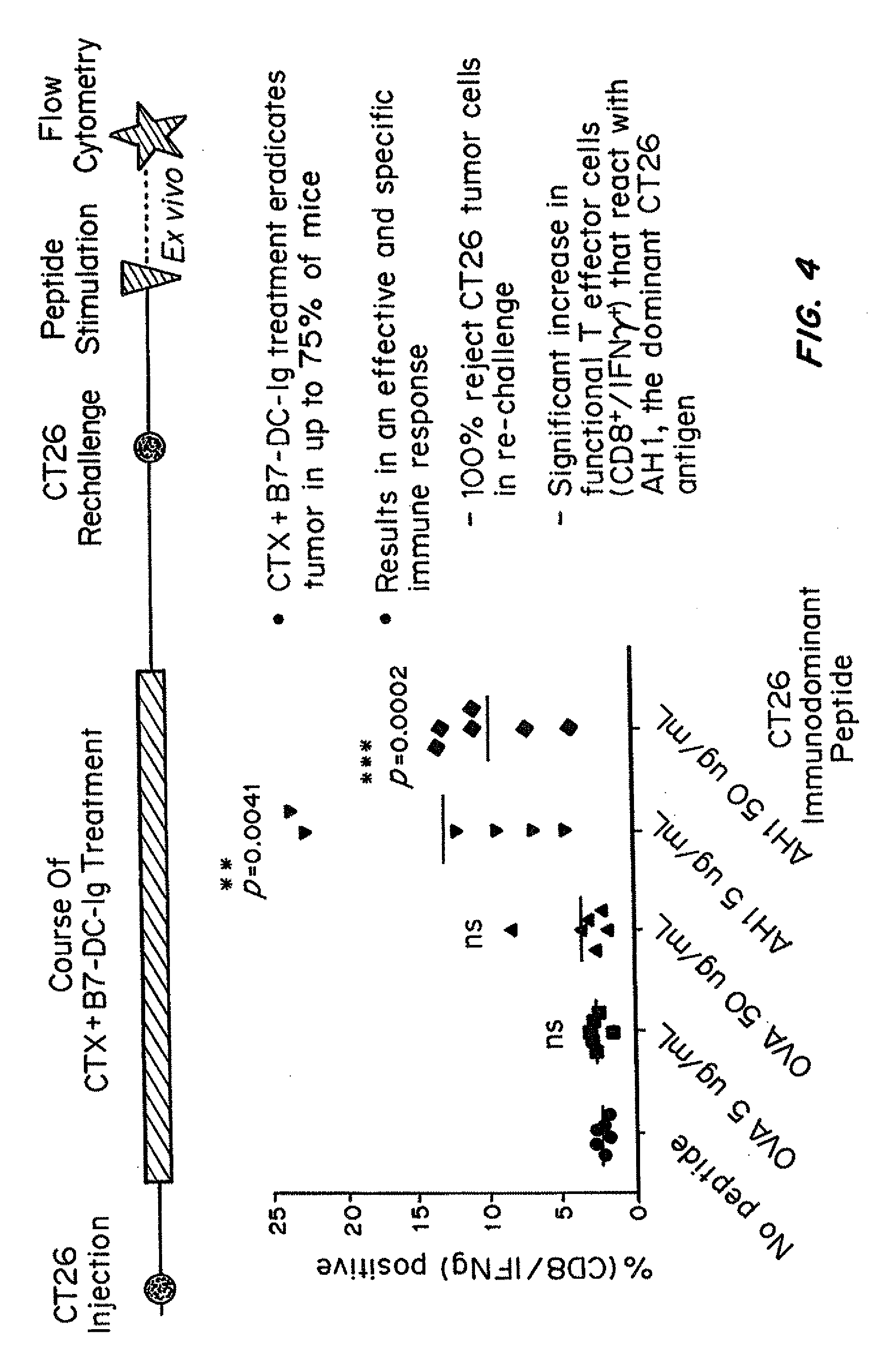Pd-1 antagonists and methods for treating infectious disease
a technology of pd-1 and antagonists, applied in the field of immunomodulatory compositions and methods for treating diseases, can solve the problems of poor initial immune activation, inability to effectively treat infectious diseases, acute and chronic infections, etc., and achieve the effect of rapid induction of protection and robust effector responses
- Summary
- Abstract
- Description
- Claims
- Application Information
AI Technical Summary
Benefits of technology
Problems solved by technology
Method used
Image
Examples
example 1
B7-DC Binding to PD-1
[0389]PD-1 binding activity of human B7-DC-Ig was assessed by ELISA. 96-well ELISA plates were coated with 100 μL 0.75 μg / mL recombinant human PD-1 / Fc (R&D Systems) diluted in BupH Carbonate / Bicarbonate pH 9.4 buffer (Pierce) for 2 hours and then blocked with BSA solution (Jackson ImmunoResearch) for 90-120 minutes. Serially diluted human B7-DC-Ig as well as human IgG1 isotype control were allowed to bind for 90 minutes. Bound B7-DC-Ig was detected using 100 μL of 0.5 μg / mL biotin conjugated anti-human B7-DC clone MIH18 (eBioscience) followed by 1:1000 diluted HRP-Streptavidin (BD Bioscience) and TMB substrate (BioFX). Absorbance at 450 nm was read using a plate reader (Molecular Devices) and data were analyzed in SoftMax using a 4-parameter logistic fit.
[0390]PD-1 binding activity of murine B7-DC-Ig was assessed by ELISA. 96-well ELISA plates were coated with 100 μL 0.75 μg / mL recombinant mouse PD-1 / Fc (R&D Systems) diluted in BupH Carbonate / Bicarbonate pH 9.4 ...
example 2
B7-DC Binding to PD-4 Expressing CHO Cells
[0392]B7-DC-Ig was first conjugated with allophycocyanin (APC) and then incubated at various concentrations with a CHO cell line constitutively expressing PD-1 or parent CHO cells that do not express PD-1. Binding was analyzed by flow cytometry. FIG. 2 shows the median fluorescence intensity (MFI) of B7-DC-Ig-APC (y-axis) as a function of the concentration of probe (x-axis). B7-DC-Ig-APC binds to CHO.PD-1 cells (solid circle) but not untransfected CHO cells (gray triangle).
example 3
B7-DC-Ig Competes with B7-H1 for Binding to PD-1
[0393]B7-H1-Ig was first conjugated with allophycocyanin (APC). Unlabeled B7-DC-Ig at various concentrations was first incubated with a CHO cell line constitutively expressing PD-1 before adding B7-H1-Ig-APC to the probe and cell mixture. FIG. 3 shows the median fluorescence intensity (MFI) of B7-H1-Ig-APC (y-axis) as a function of the concentration of unlabeled B7-DC-Ig competitor α-axis) added. As the concentration of unlabeled B7-DC-Ig is increased the amount of B7-H1-Ig-APC bound to CHO cells decreases, demonstrating that B7-DC-Ig competes with B7-H1 for binding to PD-1.
PUM
| Property | Measurement | Unit |
|---|---|---|
| affinity | aaaaa | aaaaa |
| Host resistance | aaaaa | aaaaa |
| affinities | aaaaa | aaaaa |
Abstract
Description
Claims
Application Information
 Login to View More
Login to View More - R&D
- Intellectual Property
- Life Sciences
- Materials
- Tech Scout
- Unparalleled Data Quality
- Higher Quality Content
- 60% Fewer Hallucinations
Browse by: Latest US Patents, China's latest patents, Technical Efficacy Thesaurus, Application Domain, Technology Topic, Popular Technical Reports.
© 2025 PatSnap. All rights reserved.Legal|Privacy policy|Modern Slavery Act Transparency Statement|Sitemap|About US| Contact US: help@patsnap.com



